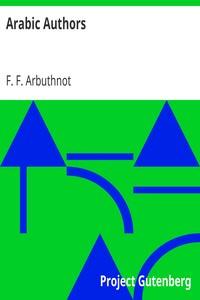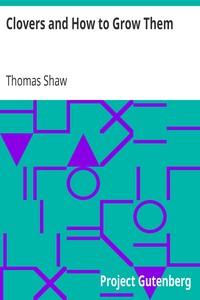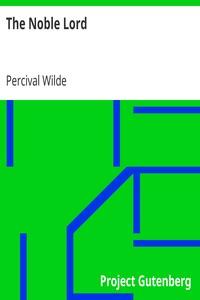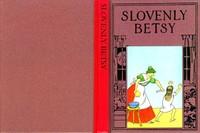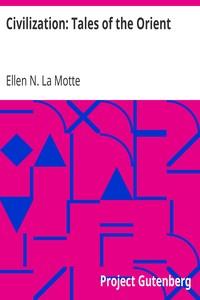|
|
Read this ebook for free! No credit card needed, absolutely nothing to pay.Words: 34868 in 19 pages
This is an ebook sharing website. You can read the uploaded ebooks for free here. No credit cards needed, nothing to pay. If you want to own a digital copy of the ebook, or want to read offline with your favorite ebook-reader, then you can choose to buy and download the ebook.

: Arabic Authors A Manual of Arabian History and Literature by Arbuthnot F F - Arabic literature History and criticism; Arabian Peninsula History@FreeBooksTue 06 Jun, 2023 in Mustafa, the celebrated Arabian, whom Haji-Khalfa always calls by the more euphonious name of Abul-Khair . This author is worthy of notice, on account of the Arabic works he wrote on biographical, historical, and especially encyclopaedic subjects. His 'Key of Felicity' will remain for ever the best encyclopaedia of Arabian sciences, representing as it does their division among the Arabs, with notices of the works of scholars in every branch of them in a most compact and comprehensive manner. He died A.D. 1560. The three most celebrated calligraphers of this century were Hamdallah, who died A.D. 1518; Mir Ali, who died A.D. 1544; and Muhammad Hussain Tabrizi, who died A.D. 1574. Their names are just as celebrated for Thuluth and Talik writing as were formerly those of Ibn Bawwab, of Ibn Hilal, and of Yakut are for Naskhi. In Egypt and Syria the characters used were always more beautiful than those of Andalusia, which survived in the Mugrib . Here, perhaps, it may be stated that the art of Arabic writing came into existence but a very short time before Muhammad. 'It was Abu Ali bin Mukla who first took the present system of written characters from the style of writing employed by the people of Kufa, and brought it out under its actual form. He had, therefore, the merit of priority, and it may be added that his handwriting was very elegant. But to Ibn Al Bawwab pertains the honour of rendering the character more regular and simple, and of clothing it in grace and beauty.' In other words, Ibn Mukla was the first who changed the Kufic into the new Naskhi character, which Ibn Bawwab improved after him by imparting rotundity and clearness to the new letters, and which Ibn Yakut Al-Mausili brought afterwards to the greatest perfection in A.D. 1200. Ibn Mukla, who was born in A.D. 885, and died A.D. 941, was vizier to the Khalifs Al-Kahir-billah and Al-Radhi-billah; but, falling into disfavour through the intrigues of his enemies, he first had his hand cut off in A.D. 937, and eventually his tongue was torn out, and he was allowed to perish in the dungeon without any assistance being offered to him. Ibn-al-Bawwab, the Penman, is said to have possessed a skill in penmanship to which no other person ever attained in ancient or modern times. He died at Baghdad A.D. 1032, and the following verses were composed as his elegy: 'Thy loss was felt by the writers of former times, And each successive day justifies their grief. The ink-bottles are therefore black with sorrow, And the pens are rent through affliction.' During the eleventh century of the Hijrah there lived Mustafa bin Abdullah Katib Jelaby, otherwise known as Haji Khalfa, and commonly called Mustafa Haji Khalfa, a man of science as a Turkish historian and geographer, but an Arabic encyclopaedist and bibliographer. He was the compiler of a work containing many thousands of titles of Arab, Persian, and Turkish books, with the names of their authors. Fluegel edited this great work under the title of 'Lexicon Enciclopaedicum et Bibliographicum,' with a Latin translation in seven bulky volumes, and it is an extremely valuable work of reference, put together with the most astonishing and persevering care, and consulted by all who desire information on Arabic, Persian, and Turkish literature. This was printed by the Oriental Translation Fund between A.D. 1835 and 1850, and will always remain as one of the most valuable works printed by that most useful society, whose extinction must ever be regretted by all Orientalists and persons interested in Oriental literature. Haji Khalfa wrote another interesting work, giving a detailed account of the maritime wars of the Turks in the Mediterranean and Black Sea and on the Danube, which has been translated by Mr. James Mitchell. The date of Haji Khalfa's death is uncertain. He is known to have been alive in A.D. 1622, and still in 1652, and he is supposed to have died in A.D. 1657. The works of Abul Khair, previously mentioned, and of Haji Khalfa, embody a mass of information, and constitute the top of the pyramid of encyclopaedical and biographical works, after which nothing worthy of mention has been written on these subjects. The basis of this pyramid had been already laid by An-Nadim, the author of the 'Fihrist,' who flourished A.D. 987, and by Ibn Khallikan, who died A.D. 1282. Mention may be made of Muhammad-Al-Amin, the learned philologist and lawyer of Damascus, who was born in that town about the middle of the eleventh and died the beginning of the twelfth century of the Hijrah, and produced a dozen respectable works, the principal of which bears the title of 'The Biographies of the Celebrated Men of the Eleventh Century,' A.H. He gives an account of a couple of hundred scholars, who represented in Egypt and in Syria the last rays of the setting sun of Arabian literature. Next to Muhammad-Al-Amin another author of about a dozen works is to be noticed, namely, Ahmad-Al Makkari, whose principal work was a history of the Muhammadan dynasties in Spain, which was translated from the copies in the library of the British Museum, and illustrated with critical notes on Spanish history, geography and antiquities, by Pascual de Gayangos, and printed for the Oriental Translation Fund of Great Britain and Ireland in A.D. 1840-43. Makkari also wrote a history of Fez and Morocco, as well as an account of Damascus. He died at Cairo A.D. 1631. Besides some historians, grammarians, philologists and poets, the eleventh century of the Hijrah produced in Syria and Egypt even astronomers and physicians, who distinguished themselves as scholars. Of writers of light literature Khafaji may be named as the chief. He composed a Diwan of ardent love poems, with two anthologies, containing specimens of verses from a couple of poets, his contemporaries. He died A.D. 1658. A few more writers might be mentioned; but their efforts strongly mark the decline of Arabic literature in the East, the cultivation of which, however, was henceforth more energetically pursued in Europe, where many works have been printed and translated. With the twelfth century of the Hijrah the history of original Arab literature may be said to have terminated, and its genius to have disappeared. A revival, however, of Arabian learning is taking place in Egypt, Syria, and North Africa, but in accordance with European models, and chiefly under European auspices. All original research has long been extinct, even among those populations whose vernacular is the Arabic language; and consequently it is the former, and not the present state of Arab literature, which is the most interesting to the people of to-day. Free books android app tbrJar TBR JAR Read Free books online gutenberg More posts by @FreeBooks

: The Noble Lord A Comedy in One Act by Wilde Percival - Drama One Act Plays@FreeBooksTue 06 Jun, 2023
|
Terms of Use Stock Market News! © gutenberg.org.in2025 All Rights reserved.

